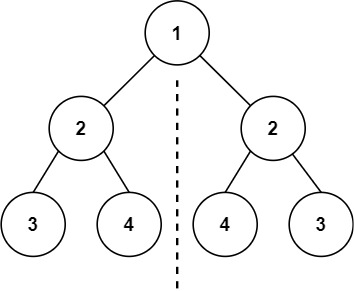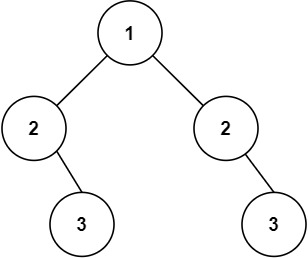Given the root of a binary tree, check whether it is a mirror of itself (i.e., symmetric around its center).
Example 1:

Input: root = [1,2,2,3,4,4,3] Output: true
Example 2:

Input: root = [1,2,2,null,3,null,3] Output: false
Constraints:
[1, 1000].-100 <= Node.val <= 100Follow up: Could you solve it both recursively and iteratively?
The core challenge of this problem is to determine if a binary tree is symmetric around its center. This means that the left subtree should be a mirror reflection of the right subtree.
Common applications of this problem include validating data structures that need to be symmetric, such as certain types of balanced trees.
Potential pitfalls include not correctly handling null nodes or assuming that the tree is always balanced.
To solve this problem, we can use two main approaches: recursive and iterative.
A naive solution might involve traversing the tree and comparing nodes, but without a clear strategy, this can become complex and inefficient.
We can optimize our approach by using recursion or iteration to compare the left and right subtrees systematically.
In the recursive approach, we define a helper function that takes two nodes and checks if they are mirrors of each other. This function will be called on the left and right children of the root.
In the iterative approach, we use a queue to perform a level-order traversal, ensuring that corresponding nodes in the left and right subtrees are mirrors of each other.
isMirror that takes two nodes.isMirror on the left child of the first node and the right child of the second node, and vice versa./**
* Definition for a binary tree node.
* function TreeNode(val, left, right) {
* this.val = (val===undefined ? 0 : val)
* this.left = (left===undefined ? null : left)
* this.right = (right===undefined ? null : right)
* }
*/
/**
* @param {TreeNode} root
* @return {boolean}
*/
function isSymmetric(root) {
// Helper function to check if two trees are mirrors of each other
function isMirror(t1, t2) {
// If both nodes are null, they are mirrors
if (t1 === null && t2 === null) return true;
// If only one of the nodes is null, they are not mirrors
if (t1 === null || t2 === null) return false;
// Check if the current nodes' values are equal and their children are mirrors
return (t1.val === t2.val) &&
isMirror(t1.right, t2.left) &&
isMirror(t1.left, t2.right);
}
// Start the recursion with the left and right children of the root
return isMirror(root.left, root.right);
}
/**
* Definition for a binary tree node.
* function TreeNode(val, left, right) {
* this.val = (val===undefined ? 0 : val)
* this.left = (left===undefined ? null : left)
* this.right = (right===undefined ? null : right)
* }
*/
/**
* @param {TreeNode} root
* @return {boolean}
*/
function isSymmetric(root) {
if (!root) return true;
// Initialize a queue to hold nodes to be compared
let queue = [];
queue.push(root.left);
queue.push(root.right);
while (queue.length > 0) {
// Dequeue two nodes to compare
let t1 = queue.shift();
let t2 = queue.shift();
// If both nodes are null, continue to the next pair
if (!t1 && !t2) continue;
// If only one of the nodes is null, the tree is not symmetric
if (!t1 || !t2) return false;
// If the values of the nodes are not equal, the tree is not symmetric
if (t1.val !== t2.val) return false;
// Enqueue the children of the nodes in the correct order
queue.push(t1.left);
queue.push(t2.right);
queue.push(t1.right);
queue.push(t2.left);
}
return true;
}
Both the recursive and iterative solutions have a time complexity of O(n), where n is the number of nodes in the tree. This is because each node is visited once.
The space complexity for the recursive solution is O(h), where h is the height of the tree, due to the recursion stack. For the iterative solution, the space complexity is O(n) due to the queue.
Potential edge cases include:
To test the solution comprehensively, consider the following test cases:
root = []root = [1]root = [1,2,2,3,4,4,3]root = [1,2,2,null,3,null,3]Use a testing framework like Jest or Mocha to automate these tests.
When approaching such problems, consider the following tips:
Understanding and solving the symmetric tree problem helps improve your skills in tree traversal and recursion. Practice with similar problems to strengthen your problem-solving abilities.
For further reading and practice, consider the following resources:
Our interactive tutorials and AI-assisted learning will help you master problem-solving skills and teach you the algorithms to know for coding interviews.
Start Coding for FREE